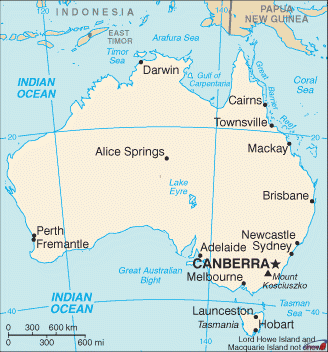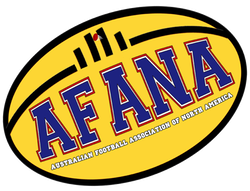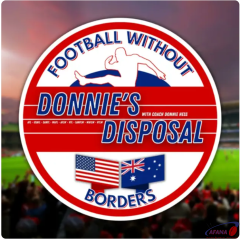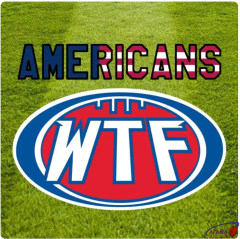Introduction to Australian Rules Football
What is Australian Rules Football?
Australian Rules Football (also "Aussie Rules" or "footy") is one of the many existing forms of football, with roots traceable from early forms of Rugby and Gaelic football, but it is uniquely Australian. Its rules were first codified in 1858, and probably predate all other modern forms of football, such as American, Canadian, Rugby Union and League, Association (Soccer) and Gaelic football. Today it is a multimillion dollar business, with a National Competition and numerous smaller leagues. Interest in the game is generally at an all time high within and outside Australia. How did it all start?Englishmen were first settled in Australia by force in 1788, when the First Fleet of "transported" English convicts arrived at what is now known as Sydney Harbour, sentenced to be exiled to the far end of the earth for life. They and those who followed, forced or not, doubtless brought their own hometown versions of football with them. Since Roman times, games involving kicking around small objects, usually leftover livestock bladders, had been played all over Europe, probably spread by the Romans themselves. In the British Isles, these evolved into the village mellays of the Middle Ages (any resemblance to the French and English word melee is totally intentional), annual brutal contests at something that usually vaguely resembled modern soccer, but with entire towns as opposing sides and the field sometimes occupying the miles between their town greens. First goal usually won, and the injuries themselves would probably have limited them to an annual event.
By the early 19th century, increased leisure time due to the Industrial Revolution led to more regular and less violent sport, and thus began demand for standard rules for football. However, these rules took most of the century to work out, especially since students at various "public" schools (private boarding schools for gentry-in-training) such as Rugby and Eton developed games of their own to play on campus. No one seems to have thought of picking up the football until William Webb Ellis ignored the rules at Rugby in 1823, but it caught on fairly quickly. The discoveries of gold in California in 1849 were followed by strikes in central Victoria in 1851. British and Irish prospectors rushed in to join the locals, all the "diggers" bringing their own variations on the theme of football into the gold fields. Australian football probably began as the compromise pickup games played by the diggers, incorporating features of Rugby, soccer and Irish games. But it took the likes of Thomas Wentworth Wills to say finally, "We shall have a game of our own." Wills' father Horatio was the first European to settle in Ararat in western Victoria, where the hills reminded him of the story of Noah landing the Ark as the Deluge receded. He was also the only settler who refused to evict the local Djabwurrung people from his land, and young Tom absorbed their culture alongside that of his fellow immigrants. One of the things they taught him was a game they called marn grook, a sort of keep-away game played with a stuffed or inflated opossum skin which featured the leaping overhead catch used today in taking high marks. Horatio wanted his son to have the best education available, so he sent Tom away to boarding schools when the time came, first in Melbourne, then to Rugby School in England, where he proved himself as a scholar and athlete, captaining the cricket and football teams. He returned in 1856 with an outstanding sporting background on two continents, taught his state cricket side everything he learned in England, and the next summer led them to their first ever win over New South Wales. Wills was convinced that the cricketers would improve further if they had something to do during the winter months, and he eventually convinced the cricketers that "a game of our own" was just the thing to maintain their fitness. The Melbourne Football Club was founded August 7, 1858, as an adjunct of the Melbourne Cricket Club; it was the first football club in Australia, and one of the first anywhere. The first game was played that very day, as two private schools, Melbourne Grammar and Scotch College, spent the day on the Richmond Paddock (just outside the present Melbourne Cricket Ground and now part of the MCG car park). Each team scored a goal that first day; the game was resumed every other Saturday for the next four weekends until it was called a draw on September 4th, after no further goals were scored. The new game spread fairly quickly, with help from the founders. Wills wrote a new set of rules for football the next year, along with associates H. C. A. "Coldy" Harrison (Wills' cousin and a fine athlete in his own right), W. J. Hammersley and J. B. Thompson. Harrison founded the club in his hometown of Geelong that same year, and others throughout Victoria (including Carlton) were well established by the time the American Civil War was over. Each had its own book of laws, similar only in generalities: irregular paddocks incorporating trees and other obstacles, and spectators, no behind posts, no running with the ball, no hand pass, no high marks (blokes could get hurt landing on surfaces like this), and more than a vague resemblance to the ancient melees. To facilitate competition between clubs, the fathers of the game and the clubs wrote a common set of rules in 1866, incorporating most of the features of the game we know today. Many of these, like the high mark, just happened to suit Harrison's athletic talents, which would have been well suited to basketball. Several of the more successful clubs banded together into the Victorian Football Association (VFA) in 1877. Through the rest of the century, the game spread along the southern coasts of Australia, spawning state leagues in what are now South and Western Australia and began attracting unprecedented crowds in the tens of thousands. (No one thought of asking these people for money until Carlton began charging admission at the turn of the century.) In any event, the issue of professional players drove the next major development. On October 2, 1896, eight leading clubs (Carlton, Collingwood, Essendon, Fitzroy, Geelong, Melbourne, St. Kilda, South Melbourne) broke away to found the Victorian Football League (VFL), the predecessor of the current national league. (In 1997, the VFA assumed the VFL's identity.) The history of the VFL and its successor, the AFL, continues in FAQ: What is the AFL?. Additional history is in this series on the AFANA website: Origins of the Laws of Australian Football
Where is Aussie Rules played?

Australia is divided into 6 states and 2 territories. Aussie Rules is the most popular form of football in Victoria, Western Australia, South Australia, Tasmania, and the Northern Territory, and has a strong following in the Australian Capital Territory (A.C.T.). While traditionally New South Wales and Queensland have been considered Rugby League strongholds, the AFL is making inroads with two franchises now in each of those states. Consider that the Brisbane Broncos, Queensland's biggest Rugby League club had 22,165 members in 2014. The AFL's Brisbane Lions had 23,247. The highest membership of a Sydney NRL club in 2014 was the South Sydney Rabbitohs with 27,543 (most in the league). The AFL's Sydney Swans had a membership of 40,126 for the same period.
Show me some Internet sources for Aussie rules football
The AFANA pages (www.afana.com) contain links to a wide variety of footy sites. By popular demand, some of those links have been incorporated into this FAQ.
History of the FAQ
This FAQ originated from a FAQ for the rec.sport.football.australian usenet newsgroup and was first created in October 1994 by Adam East, then a student at the University of Western Australia. Versions 0.1, 0.2 and 0.5 were posted to r.s.f.a over the next 2 months, and modifications were made according to feedback received. The FAQ was put onto the original Bouncedown FTP site at UWA in November 1994. It actually pre-dates the "web". The first official version (v1.0) of the FAQ was finalized on 16 December 1994. Revisions were posted as follows: V1.1 - 2 February 1995 AFANA procured Version 1.4 in March 1997 and created V1.5. Initial modifications were made by the late Dana M. Spuhler, a charter member, in May 1997. Version 1.6 updates were made by AFANA webmaster Ben Seacrist and added the history section to the FAQ, incorporated Web addresses for AFL clubs and many other football organizations, and includes wholesale changes related to season 1999. Lisa Albergo, a charter member and long time staff writer at AFANA, revised the document again in June 2006, coinciding with the debut of a new website for AFANA. Work began by the entire staff of AFANA on a long overdue update to V2.0 in April of 2015 and completed in August, 2015. Minor updates were made to get things current for 2016 season and designated v2.01. More updates to add current info were made in 2017 and designated v2.02. This process continued in 2017 through 2020 leading to versions 2.5 and 2.7. This also saw the introduction of the FAQ on club songs in V2.7. The most recent changes added more awards and other minor uupdates and the current version 2.71. This FAQ is dedicated to the memory of Dana Spuhler. |
Article last changed on Thursday, January 20, 2022 - 4:06 PM EST






